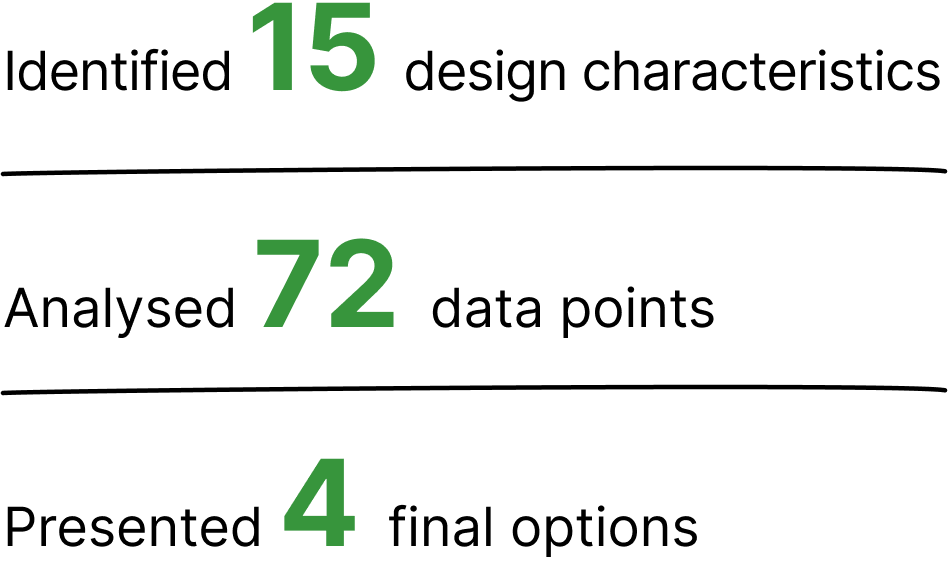Find a sustainable primary packaging material that maximises performance of eScent’s formulation while providing a great user experience.
Identified 15 important design characteristics. Analysed commercial and near-to-market materials for suitability, comparing 72 data points. Presented 4 final options.
When eScent founder Dr. Jenny Tillotson started designing a wellness-driven platform technology to replace the classic perfume bottle, she placed sustainability at the core of the process, setting ambitious goals for safe, green materials in every component. After working with Green Rose to identify high-performing green solvents for the scent formulation, she found herself needing additional help in navigating the maze of sustainable packaging options on the market.
Jenny needed a high-performing material that would keep her formulations stable and smelling fresh throughout their shelf life, while having truly sustainable properties that satisfied eScent’s core brand value. Faced with conflicting supplier claims and a lack of transparent data, Jenny needed an expert to untangle the options and make her choice easy.
Note: eScent is the trading name for Sensory Design & Technology Ltd.
The first step in scoping this project was identifying the material properties that were most important to eScent’s design philosophy. We considered the nature of the formulation, how the product would be used, and how it would be disposed of. This careful approach let us target 15 packaging characteristics that were specifically suited to eScent’s needs. The planned work included a mix of literature, computational, and market research to identify sustainable packaging with the right properties. Results would be delivered as a report summarising the best materials, their properties, and critical information on sustainability metrics to inform Jenny’s choice.

For this project, Green Rose pulled in expertise from our network to get the details right. We worked with Dr. Love-Ese Chile, a specialist in sustainable and biodegradable plastics. Together, we identified sustainable plastics and plastic alternatives that could potentially suit eScent’s product. We collated data on the properties of each material, accounting for key performance characteristics as well as sustainability metrics from feedstock to end-of-life.
Throughout our analysis, we relied on a core Green Rose philosophy: metrics are only useful when they’re grounded in the real world. We came across many sustainable materials that were biodegradable, but since eScent’s product was likely to be disposed of in clinical settings, there was little value in choosing a biodegradable material – it would end up incinerated or in landfill. Options like biobased plastics were more desirable, lowering the carbon footprint of the packaging regardless of end-of-life.
Green Rose’s unique green chemistry approach enabled us to analyse the compatibility of eScent fragrance components with the various packaging materials identified. Many plastics on the market cannot contain aromatic chemicals, resulting in an inferior product that loses its scent within weeks of being packaged. We were able to computationally identify packaging that was compatible with the planned formulation, resulting in higher product performance without costly experimental testing.

At the end of the project, we presented Jenny with four sustainable packaging options that were specifically suited to eScent’s design needs. A detailed seven-page report summarised the properties of each material, identifying advantages and disadvantages. Options for suppliers, manufacturing, and sustainable disposal were included as well.

While there is never an obvious “right” choice for sustainable packaging, Green Rose provided the information Jenny needed to make a science-based decision that was right for her company. During the project, Jenny was able to move forward with funding applications, marketing efforts, and engineering work, rather than getting bogged down for months learning about the chemistry of polymers and the difference between “compostable” and “biodegradable”.
By choosing Green Rose Chemistry for sustainable product development, Jenny accelerated her project timeline, procuring a unique combination of green chemistry and sustainable packaging expertise. She gained a new understanding of the sustainable packaging market that aligned with her company’s values and built trust with her customers.

“Green Rose Chemistry were very coherent and easy to work with! We now have data to help us move to the next stage of the development process, plus new knowledge on bio-plastic packaging options. Hope to work with Green Rose again soon!”